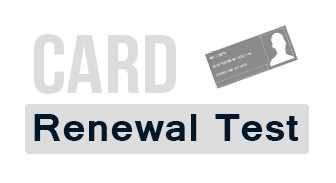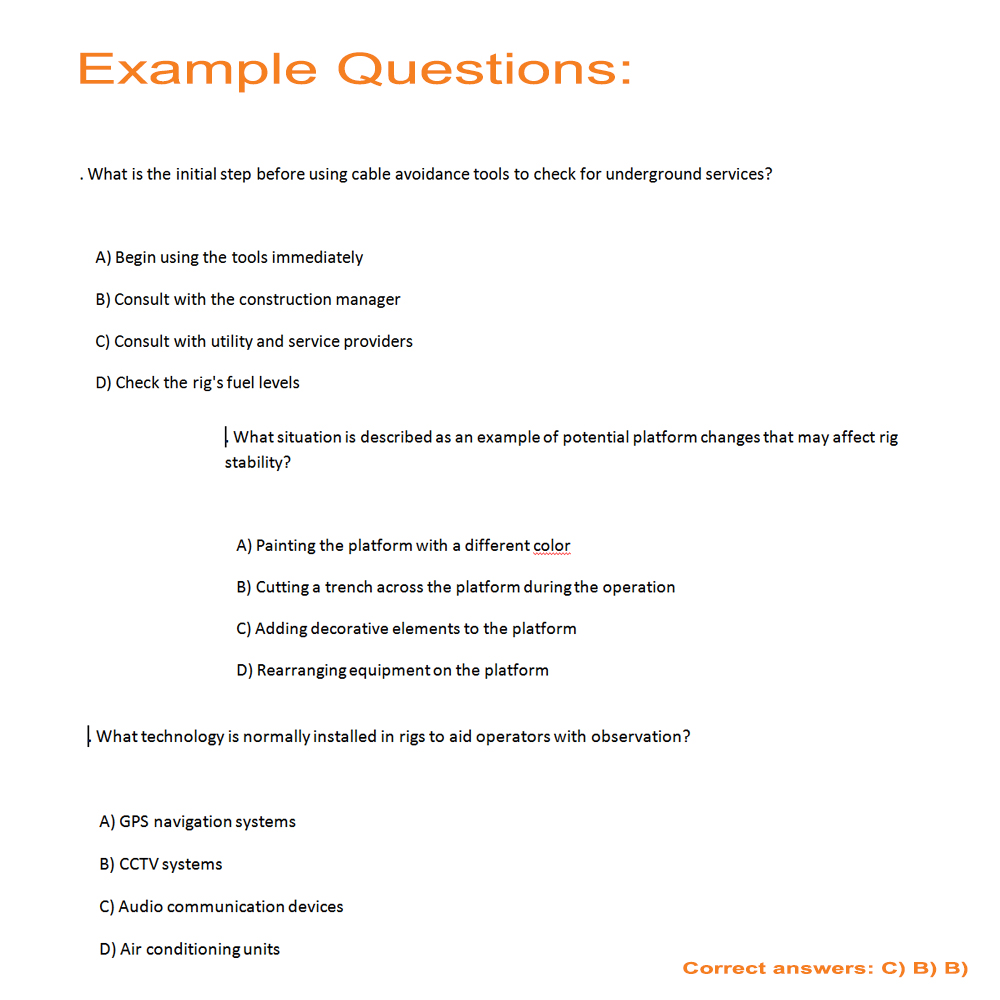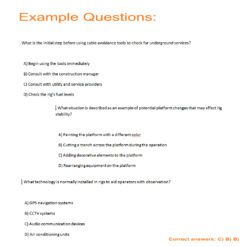RT45 CPCS Blue Card Renewal Mock Test with 110 Questions and Answers / A 45,46,47,48 Piling Rig
£15.00 Original price was: £15.00.£9.95Current price is: £9.95.
100% PASS your RT45 CPCS blue card renewal test with practice multiple choice questions – Just like the real NOCN/CPCS test!
- Questions & Answers: based on the latest RT 45 Piling Rig – CPCS Renewal Test Revision FACTSHEET
- Categories: A48 Bored above 20 Tonnes / A47 Bored below 20 tonnes / A46 Driven above 20 tonnes / A45 Driven below 20 tonnes
- Number of Multiple-choice Questions: 110
- Format: PDF
- Delivery time: Instant download after checkout
- Refunds: No refunds once downloaded, unless you ordered duplicates by mistake.
If there are any issues with your download, please email CardRenewalTest@gmail.com and we’ll send it ASAP
Ace Your RT45 Piling Rig CPCS Blue Card Renewal with Our Mock Practice Test!
Specifically tailored for categories A48 (Bored above 20 Tonnes), A47 (Bored below 20 tonnes), A46 (Driven above 20 tonnes), and A45 (Driven below 20 tonnes), this test will help you renew your certification with confidence. Let’s explore how this mock practice test can benefit operators across these categories.
Are you gearing up for your CPCS Blue Card Renewal for RT45 Piling Rig? The NOCN CPCS RT45 Piling Rig factsheet is your key resource, and we’re here to help you master it. Our comprehensive mock practice test is designed to prepare you thoroughly for the real deal. In this blog post, we’ll dive into why you need these mock questions and what valuable knowledge you’ll gain from them.
Why Do You Need CPCS Blue Card Renewal Mock Practice Tests?
1. Stay Updated with the Latest Factsheet:
- The construction industry evolves, and so do the certification requirements. Our mock practice test is based on the latest NOCN CPCS RT45 Piling Rig factsheet. This ensures that you’re studying the most up-to-date information and guidelines.
2. Evaluate Your Knowledge:
- Wondering if you’ve absorbed all the essential information? Our mock questions allow you to assess your understanding of the RT45 Piling Rig certification requirements. It’s a fantastic way to identify areas where you may need further study.
3. Familiarize Yourself with Exam Format:
- The actual CPCS Blue Card Renewal exam follows a specific format. Our mock practice test replicates this format, giving you a chance to get comfortable with the structure, types of questions, and time constraints.
4. Reduce Exam Anxiety:
- Anxiety can affect your performance on test day. Practicing with our mock questions helps alleviate anxiety by increasing your confidence and ensuring you’re well-prepared.
What Will You Learn from Our Mock Practice Test?
1. In-Depth Knowledge of RT45 Piling Rig:
- Our questions cover various aspects of piling rig operations, including safety procedures, equipment checks, and site conditions. You’ll gain comprehensive insights into what it takes to operate RT45 Piling Rigs safely and efficiently.
2. Familiarity with Key Concepts:
- The mock test focuses on critical concepts from the NOCN factsheet, ensuring you understand key terminology, safety regulations, and best practices.
3. Problem-Solving Skills:
- Real-world scenarios and challenges are integrated into our questions. You’ll develop problem-solving skills that are essential for operating RT45 Piling Rigs effectively and safely.
Conclusion:
Preparing for your RT45 Piling Rig CPCS Blue Card Renewal doesn’t have to be stressful. Our mock practice test provides a valuable tool to enhance your knowledge, boost your confidence, and ensure you’re well-equipped for certification renewal. Don’t leave your success to chance—get ready to ace the exam with our comprehensive mock questions.
Don’t wait! Secure your success in the CPCS Blue Card Renewal for RT45 Piling Rig by practicing with our mock test today. Book your CPCS renewal test with confidence, knowing you’re fully prepared to excel.
These are the summarized learning points from the NOCN RT45 Factsheet:
Preparation for Work:
- Piling activities often rely on specialized machinery, including dedicated piling rigs adapted from excavators.
- Proper pre-use checks are essential to ensure safe operation, and any faults or defects must be reported immediately.
- Checks on auxiliary hoist ropes are crucial, ensuring they are in good condition, free of kinks and broken wires, and sufficiently lubricated.
- Prior to work, checks for underground services must be conducted, consulting with utility providers and using cable avoidance tools as needed.
- Piling work requires a permit to pile, which is issued only after confirming the absence of underground services in the piling area.
Stability and Working Platforms:
- Piling rigs have a higher center of gravity and can become unstable, emphasizing the need for careful planning of travel routes and working platforms.
- Travelling on inclines requires specific considerations, including weight distribution and mast positioning to prevent instability.
- Effective support platforms of sufficient size are essential for rig stability, and a working platform certificate must be issued by a competent person.
- Water run-off channels on the platform should be regularly checked to prevent water ingress that can affect ground support and rig stability.
- In areas with a high water table, operators must be aware of the potential impact on platform integrity.
- Alterations to platforms during piling operations should be checked by a competent person before resuming work.
- Rig operators must be mindful of supporting personnel to prevent accidents during operations.
Working Safely and with Others:
- Operators must consider site conditions, especially regarding overhead power lines, and maintain safe distances to prevent accidents.
- Engine shutdown and equipment lowering to ground level are good practices when operators leave the cab.
- Operators should avoid keeping the safety bar in the active position lever when exiting the cab to prevent unintentional machine movement.
- Clothing checks before starting the engine help prevent accidents in the working area.
- Exclusion zones around the piling area are necessary to prevent falling components or ejected materials.
- Awareness of supporting personnel and clearances during rig operations is crucial.
- Concrete pumping is common, and delivery schedules should be part of the piling planning process.
- Delays in concrete delivery can lead to blockages in the pipeline, requiring potential pipework changes.
- Planning platform location must consider distances to nearby slopes or trenches, determined by a competent person.
- Reversing of vehicles and plant should be minimized, with emphasis on preventing it whenever possible.
- CCTV systems in rigs may distort distance perception; hence, operators should use multiple methods of observation.
- Operators must be cautious when extracting temporary casings or piles due to the risk of overloading and rig instability.
Piling Operations:
- Some piling rigs are equipped with an auxiliary winch for lifting materials directly connected with the work.
- Lifting general loads turns the rig into a crane, necessitating compliance with lifting requirements.
- Hoist ropes are subjected to stress during both piling and lifting tasks and require regular checks to prevent deterioration or breakage.
- Travelling and working on an ineffective platform can cause instability, necessitating operator awareness of applied forces and pressures.
- Total rig weight during travel can create high ground-bearing pressures through the tracks, including components like the counterweight, mast, rotary table, and auger.
- Ground-bearing pressure may increase due to factors like the pull-down force of a rotating auger.
- Weather conditions, such as cold weather, can influence piling methods, leading to the use of pre-cast piles to prevent freezing of concrete.
These summarized learning points cover a wide range of aspects related to piling rig operation, safety, and best practices, making them valuable for operators seeking CPCS Blue Card Renewal across various piling rig categories.
1 review for RT45 CPCS Blue Card Renewal Mock Test with 110 Questions and Answers / A 45,46,47,48 Piling Rig
Add a review Cancel reply
Related products
CPCS Blue Card Renewal Tests
RT19 CPCS Blue Card Renewal Mock Test with 123 Questions and Answers / A19 Grader
CPCS Blue Card Renewal Tests
CPCS Blue Card Renewal Tests
RT65 CPCS Blue Card Renewal Mock Test with 133 Questions and Answers / A65 Demolition Plant
CPCS Blue Card Renewal Tests
RT42 CPCS Blue Card Renewal Mock Test with 117 Questions and Answers / A42 Crusher
CPCS Blue Card Renewal Tests
RT17 CPCS Blue Card Renewal Mock Test with 144 Questions and Answers / A17 Telescopic Handler
CPCS Blue Card Renewal Tests
RT05 CPCS Blue Card Renewal Mock Test with 105 Questions and Answers / A05 Dragline
CPCS Blue Card Renewal Tests
RT22 CPCS Blue Card Renewal Mock Test with 144 Questions and Answers / A22 Tracked Loading Shovel
CPCS Blue Card Renewal Tests
RT66 CPCS Blue Card Renewal Mock Test with 133 Questions and Answers / A66 Compact Crane

















Alex –
This mock test is chill, mate. Like, it’s got questions and stuff. Good if you’re not to excited into reading the factsheet, you know?